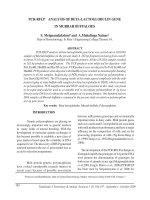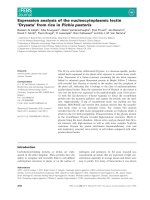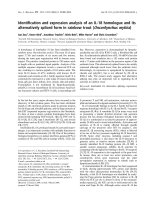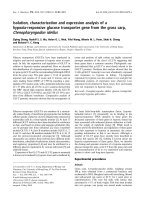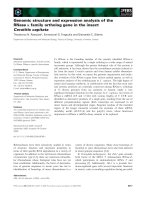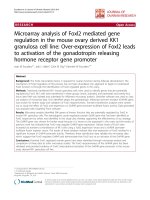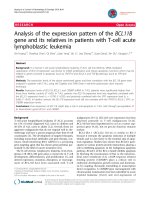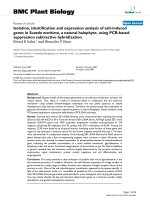Expression analysis of GFAP like gene in zebrafish embryogenesis
Bạn đang xem bản rút gọn của tài liệu. Xem và tải ngay bản đầy đủ của tài liệu tại đây (800.6 KB, 79 trang )
EXPRESSION ANALYSIS OF GFAP-LIKE GENE
IN ZEBRAFISH EMBRYOGENESIS
ANITA BALAKRISHNAN
NATIONAL UNIVERSITY OF
SINGAPORE
2007
EXPRESSION ANALYSIS OF GFAP-LIKE GENE
IN ZEBRAFISH EMBRYOGENESIS
ANITA BALAKRISHNAN
A THESIS SUBMITTED
FOR THE DEGREE OF MASTER OF SCIENCE
DEPARTMENT OF ANATOMY
NATIONAL UNIVERSITY OF SINGAPORE
2007
1
ACKNOWLEDGEMENTS
I would like to express my sincere and heartfelt gratitude to my supervisors A/Prof
Samuel S W Tay and Dr. S T Dheen, for their continued guidance, trust, patience and
many invaluable suggestions provided during the course of the project.
I am greatly indebted to Professor Ling Eng Ang, Head, Department of Anatomy for
giving me a chance to work in the department.
I would like to thank A/Prof Vladimir Korzh for giving me the opportunity to work in his
laboratory and for his suggestions and advice for the project and thank all members of his
lab; Dr. Haw Tien Fong for teaching me the required skills and for the many discussions;
Kar-Lai Poon and Lee-Thean Chu for all their help and to all the rest of the lab members
for making my experience there very memorable.
I would like to thank Dr. Alexander Emelijanov and Mr.Anil Kumar M for their
contributions to this project.
I would like to acknowledge my gratitude to Mrs Yong Eng Siang and Mrs Ng Geok Lan
for their excellent technical assistance; Mr Yick Tuck Yong for his assistance in
computer work; Mrs Ang Lye Gek Carolyne, Mrs. Diljit Kaur Bachan Singh and Mrs
Teo Li Ching Violet for their secretarial assistance; as well as Ms.Devi, Ms.Thenmozhi
and Ms.Jayanthi for their support.
2
I would like to thank the staff and students of theNeuroscience Lab and Histology Lab
and all other staff members and my fellow graduate students of the Department of
Anatomy for contributing towards the successful completion of the project.
I would like to thank the National University of Singapore for the financial assistance in
the form of a research scholarship.
Last, but not the least I want to thank my parents, my husband and my brother for their
constant support and encouragement.
3
TABLE OF CONTENTS
ABSTRACT
5
LIST OF TABLES
7
LIST OF FIGURES
8
ABBREVIATIONS
9
CONFERENCE PARTICIPATION
11
1
INTRODUCTION
1.1
GLIAL FIBRILLARY ACIDIC PROTEIN
1.2
DESCRIPTION OF THE cDNA FRAGMENT UNDER STUDY
1.3
ZEBRAFISH: A GOOD MODEL FOR DEVELOPMENTAL STUDY
1.3.1 Overview of embryonic development in Zebrafish
1.3.2 Development of the zebrafish CNS
1.3.2.1 Specification of the neuroectoderm
1.3.2.2 Regionalization of the neural tube
1.3.2.3 Neurogenesis
1.4
Objectives of the present Study
12
12
14
17
19
23
24
24
25
26
2
MATERIALS AND METHODS
2.1
ZEBRAFISH
2.1.1 Fish Maintenance
2.1.2 Stages of embryonic development
2.2
DNA APPLICATIONS
2.2.1 One-step RT-PCR
2.2.2 DNA Electrophoresis
2.2.3 Transformation
2.2.4 Isolation and purification of plasmid DNA
2.2.4.1 Miniprep of plasmid DNA
2.2.4.2 Midiprep plasmid preparation
2.2.5 Restriction digest and processing of linearized DNA
2.3
RNA APPLICATIONS
2.3.1 Isolation of total RNA from Zebrafish tissue
2.3.2 In situ hybridization
2.3.2.1 Antisense probe synthesis
2.3.2.2 Probe precipitation
2.3.2.3 Preparation of staged Zebrafish embryos
2.3.2.4 Proteinase K treatment
2.3.2.5 Prehybridization
2.3.2.6 Hybridization
2.3.2.7 Preparation of pre-absorbed anti-DIG antibody
27
27
27
27
28
28
28
29
29
29
30
31
32
32
33
33
33
33
34
34
34
35
4
2.3.2.8 Incubation with pre-absorbed antibodies
2.3.2.9 DIG staining
2.4
PROTEIN APPLICATIONS
2.4.1 Immunohistochemical staining
2.5
ADDITIONAL TECHNIQUES
2.5.1 Microinjection
2.5.2 Making of sub-slides
2.5.3 Cryostat sectioning
2.5.4 Mounting and Photography
35
36
36
36
37
37
38
39
39
3
3.1
3.1.1
3.1.2
3.2
3.3
3.3.1
3.3.2
41
41
41
43
49
51
51
RESULTS
Expression analysis of zfgfap-l
Temporal expression analysis of zfgfap-l
Expression analysis of zfgfap-l by whole-mount in situ hybridization
Expression analysis of zfgfap-l in mindbomb mutants (mib-/-)
Functional analysis of zfgfap-l
Injection of zfgfap-l morpholino shows no apparent phenotype
Expression of GFAP protein in wild type and zfgfap-l morpholino
injected embryos
3.3.3 Expression of neurogenin1 in wild type and zfgfap-l morpholino
injected embryos
3.3.4 Expression of neuroD in wild type and zfgfap-l morpholino
injected embryos
4
4.1
4.2
4.3
51
53
53
DISCUSSION
Expression analysis of zfgfap-l in wild type embryos
Expression analysis of zfgfap-l in mib-/- embryos
Expression of GFAP in wild type and zfgfap-l morpholino
injected embryos
Expression of neuroD and neurogenin1 in wild type and zfgfap-l
morpholino injected embryos
60
5
CONCLUSION
63
6
REFERENCES
64
7
7.1
APPENDIX
Composition of buffers
76
76
4.4
56
56
58
59
5
ABSTRACT
The present study focuses on a cDNA fragment of 2.6 kb coding for glial fibrillary acidic
protein (GFAP) related gene in zebrafish. Earlier work in the lab revealed that this gene
showed 72% homology, at the amino acid level, with the mammalian gene coding for
GFAP. Due to variations observed in sequence of head domain of GFAP and in
expression pattern compared to that of rodent GFAP, this gene was named as zebrafish
GFAP like gene (zfgfap-l)( Gene Bank Accession No: AY 397679).
In this project, the expression pattern of zfgfap-l was studied by RT-PCR and in situ
hybridization. RT-PCR results showed that the expression of zfgfap-l started as early as
1.5 hours post-fertilization (hpf) and increased steadily up to 10 hpf, then became a
constant level of expression till 30 hpf. In embryos at sphere stage, the expression was
detected in the cells of the superficial layer by in situ hybridization. After gastrulation,
the expression became restricted to the neural tube, particularly in the presumptive
forebrain, midbrain and posterior neural tube. This expression pattern continued to be
similar at least until 24 hpf. At 48 hpf, the expression was mainly detected in the
subventricular zone of the forebrain, midbrain, and hindbrain and the dorsoventral axis of
the presumptive spinal cord. This expression pattern of zfgfap-l in neural progenitor cells
prompted the present author to speculate that this gene could be one of the key molecules
involved in zebrafish neurogenesis. In accord with this, zfgfap-l was found to be absent
in several distinct locations of mindbomb mutants which have a defective Delta-Notch
signaling pathway, resulting in excessive differentiation of progenitors into the neuronal
phenotype.
6
These results suggest that maternally transferred zfgfap-l transcripts continue to be
present in the precursors of neuronal and non-neuronal cell populations during early
embryogenesis and subsequently become restricted to the cellular populations in the
subventricular zone where the neural stem cells lie.
To confirm if zfgfap-l was indeed associated with progenitors, zfgfap-l morpholino was
microinjected into embryos and the expression of two proneural markers- neuroD and
neurogenin1 (ngn1) was examined. If indeed zfgfap-l was associated with progenitors,
there would be significant changes in the expression of neuroD and ngn1. The expression
was found to be similar in both wild type and morpholino injected embryos. However,
more work needs to be done since there are a number of other factors (like redundancy of
zfgfap-l) that may be involved.
7
LIST OF TABLES
Table 1:
Summary of the principal events during Zebrafish embryogenesis 22
8
LIST OF FIGURES
Fig 1: Sequence analysis and mapping of zfgfap-l
15
Fig 2: Representative stages of zebrafish embryogenesis
21
Fig 3: RT-PCR analysis of zfgfap-l and β-actin
42
Fig 4: In situ hybridization of zfgfap-l on 6, 11 and 18 hpf embryos
44
Fig 5: In situ hybridization of zfgfap-l on 24 hpf embryos
46
Fig 6: In situ hybridization of zfgfap-l on 30 hpf embryos
47
Fig 7: In situ hybridization of zfgfap-l on 48 hpf embryos
48
Fig 8: In situ hybridization of zfgfap-l on 48 hpf mib-/- embryos
50
Fig 9: Whole-mount GFAP immuno-staining on 48 hpf
zfgfap-l morpholino injected and wild type embryos
52
Fig 10: In situ hybridization of ngn1 on 30 hpf
zfgfap-l morpholino injected and wild type embryos
54
Fig 11: In situ hybridization of neuroD on 30 hpf
zfgfap-l morpholino injected and wild type embryos
55
9
ABBREVIATIONS
%
µg
µl
AP
BCIP
bHLH
bp
BMP
BSA
C
Ca(NO3)2
CNS
DIG
DMSO
DNA
EB
FBS
FCS
GFAP
h
H2O
HCl
hpf
IgG
K2 HPO4
kb
KCl
LB amp+
LB
M
MgSO4
mib
min
ml
mM
mRNA
N
Na2HPO4
NaCl
NBT
ngn1
NGS
PBS
Percent
Microgram
Microlitre
Alkaline Phosphatase
5-bromo, 4-chloro, 3-indolil phosphate
Basic Helix Loop Helix
Basepair
Bone Morphogenetic Protein
Bovine Serum Albumin
Celsius
Calcium nitrate
Central Nervous System
Digoxygenin
Dimethyl Sulphoxide
Deoxyribonucleic acid
Elution Buffer
Fetal Bovine Serum
Fetal Calf Serum
Glial Fibrillary Acidic Protein
Hours
Water
Hydrogen chloride
Hours post fertilization
Immunoglobulin G
Dipotassium hydrogen phosphate
Kilobase
Potassium chloride
LB medium containing ampicillin
Luria-Bertani broth
Molar
Magnesium sulphate
mindbomb gene
Minutes
Milliliter
Millimolar
Messenger RNA
Normality
Sodium di-hydrogen phosphate
Sodium chloride
Nitro Blue Tetrazolium
neurogenin1
Normal Goat Serun
Phosphate Buffered Saline
10
PBT
PFA
RNA
rpm
RT-PCR
sec
SSC
TESPA
tRNA
UV
V
zfgfap-l
Phosphate buffered saline with 0.1% Tween-20.
Paraformaldehyde
Ribonucleic acid.
Revolutions per minute
Reverse Transcriptase Polymerase Chain Reaction
Seconds
Sodium saline citrate
Aminopropyl triethoxysilane
Transfer RNA
Ultraviolet
Volts
zebrafish GFAP like gene
11
CONFERENCE PARTICIPATION
Poster presentation on “Expression analysis of GFAP-like gene on zebrafish
embryogenesis” in the 6th National Symposium on Health Sciences, KL, 2006.
12
1
INTRODUCTION
1.1
Glial Fibrillary Acidic Protein (GFAP)
Glial Fibrillary Acidic Protein (GFAP) is a type III protein of the intermediate filament
family. GFAP was first characterized as the major intermediate filament protein of
mature astrocytes in the Central Nervous System (CNS) (Eng et al., 1970). Mammalian
GFAP has a characteristic structure composed of a highly conserved central alpha-helical
rod domain flanked by non-helical head and tail domains (Onteniente et al., 1983; Eng et
al., 2000).
GFAP is a universally recognized marker for the astrocyte cell type. It is a key
component of the astrocyte cytoskeleton (Cameron and Rakic, 1991). Astrocytes are the
major non-neuronal components of the CNS. Interactions between neurons and astrocytes
are critical for signaling, energy metabolism, extracellular ion homeostasis, volume
regulation and neuroprotection in the CNS. The largest portion of the astrocyte
membrane faces the synapse and the remainder abuts the capillaries forming end foot
processes. The astrocyte end foot process domain contributes to the induction and
maintenance of the blood-brain barrier, uptake of nutrients from the capillaries, ammonia
detoxification and buffering of extra-cellular potassium (K+) ions. Astrocytes also play a
key role in the regulation of synaptic levels of glutamate (Hertz and Zielke., 2004).
Astrocytes provide metabolic support to neurons, protect them against oxidative stress
and provide a parallel pathway for propagation and modulation of excitatory signals in
the brain (Benarroch., 2006). Recently it has also been shown that astrocytes can also
instruct unspecified cells to become neurons during neurogenesis (Song et al., 2002),
13
although neurons can be identified much earlier than the glial cells during
neurodevelopment. The two main regions where the neural stem cells are thought to
reside are the hippocampus and the areas surrounding the fluid filled ventricles in the
middle of the brain and spinal cord-sub ventricular zone (Svendsen CN., 2002).
Subventricular astrocytes have great potential to reproduce neurons (Steindler, 1993;
Doetsch et al., 1999) especially in the forebrain zone, which is the most dynamic of the
brain’s neurogenic regions.
As a result of trauma, disease, genetic disorder or chemical exposure, astrocytes in the
CNS become reactive and respond by a process called astrogliosis, which is characterized
by rapid synthesis of GFAP intermediate filaments (Eng et al., 2000). The cellular
specificity of GFAP makes it the universally recognized marker for astrocytes (Steinert
and Roop., 1988; Tardy et al. 1989) and the role of GFAP seems vital in CNS
differentiation processes. GFAP expression has been reported to be observed during late
prenatal and early postnatal development in rodents and first quarter of pregnancy in
humans (Landry et al., 1990; Lazarini et al., 1991; Sarthy et al., 1991; Voronina and
Preobhrazehensky, 1994). Mutations in coding region of GFAP have been associated
with Alexander disease, a genetic disorder of astrocytes (Brenner et al., 2001). It is still
unclear as to how altered GFAP might lead to Alexander disease. One hypothesis is that
altered GFAP blocks the normal assembly of intermediate filaments; leading to protein
deposits inside the cell, thereby normal astrocyte functions, such as interactions with
other specialized cells in the brain are disturbed. This may result in the inability to
maintain the blood-brain barrier (Li et al., 2005).
14
In zebrafish, goldfish GFAP immuno-reactivity has been shown to first appear in the
brain at 15 hpf (Marcus and Easter, 1995). However, it has been established that GFAP
may exist in more than one form in lower vertebrates as reported in Xenopus (Szaro and
Gainer, 1988).
1.2
DESCRIPTION OF THE cDNA FRAGMENT UNDER STUDY
A zebrafish cDNA fragment of size 2.6 kb was isolated earlier in the lab from a zebrafish
EST. Sequence analysis revealed a 1083- bp ORF, preceded by 260 untranslated bases
and a 1311 bp 3’UTR (Gene Bank Accession No: AY 397679). Translation by Blast
search (Altschul et al., 1997), predicted a 361 amino acid protein sequence having about
72 % homology with mouse, rat and human GFAP. Hence, the gene that was isolated was
named as zebrafish GFAP like gene (zfgfap-l). GFAP is composed of a highly conserved
central α helical rod domain flanked by non-helical head and tail domains. The rod
domains and the non-α helical tail domains are well conserved among the species
analyzed. In addition, alignment of head domains of mouse and human GFAP with that
of zfgfap-l reveals that the PR-box motif of the zfgfap-l differs from that of mouse and
human GFAP (Fig 1A). However, the phylogenetic analysis indicates that zfgfap-l has a
close relationship with the human and mouse GFAP (Fig. 1B). Due to differences
observed in the sequence and expression pattern from the mammalian GFAP, this gene
has been named as the zebrafish GFAP–like gene (zfgfap-l). Further, mapping analysis
reveals that this gene is linked to zebrafish LG3 (Fig. 1C).
15
Fig 1: Sequence analysis and mapping of zfgfap-l
1A. Amino acid sequence alignment of the head domain of zfgfap-l with the human and mouse GFAP head
domains. Conservative residues are indicated in bold letters. Predicted phosphorylation sites are underlined.
GFAP PR-box motif in human and mouse indicated by arrows. The leucine zipper pattern in the zebrafish
GFAP is shown in italic. B. Phylogenetic analysis reveals that the zfgfap-l has a closer relationship with
16
human and mouse GFAP. Numbers in nodes indicate the confidence of phylogenetic analysis (probability
in 100 bootstrap analysis). Mean bootstrap value of consensus tree (sd): 64% (± 29%). Accession numbers
are: zebrafish GFAP #AY 397679; human GFAP # P14136; mouse GFAP # P03995; human peripherin
#P41219; mouse peripherin #P15331; goldfish plasticin #P313393; zebrafish plasticin # AAC34932;
zebrafish desmin # AAB03217; human desmin #P17661; zebrafish vimentin # AAC98491; human
vimentin #P08670; mouse vimentin #P20152; zebrafish gefiltin # AAC34933; Xenopus xefiltin #
AAB41403; human α-internexin #AAB34482; mouse α-internexin #P46660. C. Linkage map analysis
reveals that zfgfap-l is in the region of zebrafish LG3
17
1.3
Zebrafish: A Good Model for Developmental Study
Zebrafish, Danio rerio is a cyprinid fish found naturally in the rivers of India and
Pakistan. The work of G.Streisinger drew peoples’ attention to the potential of the
zebrafish as an effective experimental system, which is highly suited to genetic analysis
(Streisinger et al., 1981). Adult zebrafish are only about an inch long, so large numbers
can be maintained relatively inexpensively in a small space. They reach sexual maturity
in around three months, and a large number of eggs are produced during every mating.
The zebrafish embryos develop externally, and are optically clear, making it possible to
observe the entire course of early development (Kimmel et al., 1995). The clarity of the
embryos enables scientists to label individual cells and their fate can be followed to learn
how mutations affect embryonic development. The optical clarity of embryos allows noninvasive, direct, real-time video microscopic imaging of any portion of the embryo. It
also permits whole-mount in situ hybridization analysis of gene expression with
extraordinarily high resolution.
A number of tools and methodologies have been developed to exploit the advantages of
the zebrafish system. Experimental manipulation of embryos can be done by techniques
such as microinjection of biologically active molecules, microbead implantation, cell
transplantation, fate mapping and cell-lineage tracing (Stainier et el., 1993; Mizuno et al.,
1999; Holder and Xu, 1999; Kozlowski and Weinberg, 2000; Reifers et al., 2000).
In addition to all the above mentioned advantages, there are techniques for producing
homozygous diploid fish (Streisinger et al., 1981). Also in zebrafish, mutants can be
easily identified and their parents can still be bred to keep the mutation in the
18
heterozygotes. By mating these heterozygotes, the mutant phenotype will continue to be
expressed and therefore available to be studied. The zebrafish screening strategies have
provided hundreds of developmental mutations in zebrafish (Development. Volume 123,
1996). The zebrafish is highly amenable for genetic analysis and this has been an
extremely valuable tool for the identification of developmentally important genes and
elucidating their function in vivo (Driever et al., 1994). For example, through a forward
genetic approach, a number of mutations have been used to study early embryonic
patterning (Mullins and Nusslein-Volhard., 1993) and neuronal diversity in the retina
(Malicki et al., 2000).
Despite all the above mentioned advantages, zebrafish also has a few drawbacks. The
mutants available for zebrafish are by no means saturating. Many genes, when mutated
will lead to very early developmental arrest or death, thus eluding screens designed
around observable phenotypic alterations. In addition, techniques for targeted
mutagenesis (similar to “knockout” mice) are currently unavailable in the zebrafish.
Another factor to be borne in mind is that, there is now substantial evidence that
tetraploidization, rediploidization have taken place during the early evolution of the
teleost and that hundreds of duplicate pairs generated by this event has been maintained
over millions of years of evolution (Volff., 2005).
In a nutshell, given its numerous strengths as a molecular genetic and embryological
system, the zebrafish will undoubtedly contribute to our knowledge in vertebrate
development.
19
1.3.1
Overview of embryonic development in zebrafish
The knowledge of the stage-by-stage development of the zebrafish and a detailed
understanding of its morphology and anatomy at every stage are of great importance in
analyzing the spatial and temporal expression patterns of a novel gene, in order to deduce
its significance in the development of the organism.
The embryonic development of the zebrafish from its one cell stage to five days post
fertilization, when the newly hatched larva starts feeding has been described by Kimmel
et al., 1995.
Development (Fig 2) starts from the one-cell stage (or the zygotic period) and this stage
is characterized by the streaming of the cytoplasm towards the animal pole to form the
blastodisc.
The next stage is the cleavage period (0.7 hpf-2.2 hpf). Cell cycles occur rapidly and
synchronously. These cells, known as blastomeres, accumulate over the yolk cell.
The blastula stage (2.25 hpf-5.25 hpf) follows next, when the embryo is ball shaped,
after seven cleavages and reaches the 128 cell stage. The cell cycles during the early
blastula period are metasynchronous. Important events during this stage are the mid
blastula transition, formation of the yolk syncytial layer (YSL) and the beginning of
epiboly. Epiboly can be defined as the thinning and spreading of both the YSL and the
blastodisc over the yolk cell.
20
The next stage is the gastrula period (5.25 hpf-10 hpf). Epiboly continues; involution
commences and leads to the formation of two layers of cells-epiblast and hypoblast. The
cells of the epiblast and hypoblast converge to the dorsal side of the embryo to create the
primordium of the body axis-an embryonic shield (Strahle and Blader., 1994; Kimmel et
al., 1995).
Segmentation period follows next (10.3 hpf-24 hpf). Morphogenetic movements lead to
the development of somites (segments). The rudiments of primary organs are visible, tail
bud becomes visible and the embryo elongates. The anterior-posterior axis and the dorsoventral axis are clearly defined.
The pharyngula period (24 hpf-48 hpf) is the next stage. The embryo is a bilaterally
organized creature, with a well developed notochord and the nervous system is also
developed.
The hatching period (48 hpf-72 hpf) follows next. Hatching is indicated by the rapidly
developing rudiments of the pectoral fins, the jaws and the gills.
21
Fig 2: Representative stages of Zebrafish embryogenesis (Haffter et al., 1996)
22
Period
Hpf
Zygote
0
Cleavage
0.75
Description
The newly fertilized egg till the completion of the first zygotic
cycle
Cell cycles 2 through 7 occur rapidly and asynchronously
Rapid metasynchronous cell cycles give way to lengthened
Blastula
2.25
asynchronous cell cycles at the mid blastula transition; epiboly
begins
Morphogenetic movements of involution, convergence and
Gastrula
5.25
extension form the epiblast, hypoblast and embryonic axis;
through the end of epiboly
Segmentation
10.00
Somites, pharyngeal arch primordia, and neuromeres develop;
primary organogenesis; earliest movements; the tail appears
Phylotypic-stage embryo; body axis straightens from its early
Pharyngula
24.00
curvature about the yolk sac; circulation, pigmentation, and fins
begin to develop
Completion of rapid morphogenesis of primary organ systems;
Hatching
48.00
cartilage development in head and pectoral fins; hatching occurs
asynchronously
Early larva
72.00
Swim bladder inflates; food-seeking and active avoidance
behaviors
Table 1: Summary of the principal events during Zebrafish embryogenesis*
*
/>
23
1.3.2
Development of the zebrafish CNS
Neurogenesis may be subdivided into several distinct processes
•
Establishment of neural competence of the ectoderm (neural induction).
•
Subdivision of the CNS into regions with distinct properties (regionalization).
•
Morphogenetic transformation of the neural plate into a neural tube (neurulation).
•
Generation of connections between neurons within the CNS and between the CNS
and axons (axonogenesis).
The zebrafish CNS originates as an ectodermal epithelium on the dorsal side of the
embryo. This region forms a structure called the neural plate with a dorsomedial
thickening of cells.The neural plate is formed immediately after gastrulation (Schmitz et
al., 1993).
The neural plate is visible as a thickening comprising dorsal and lateral parts of the
epiblast (Schmitz et al., 1993). The neural plate, at the completion of gastrulation, is
morphlogically distinct and is highlighted by the appearance of a medial thickening
overlying the notochord and two lateral swellings at the lateral boundaries of the neural
plate (Schmitz et al., 1993). Following this, the lateral swellings move towards the dorsal
midline while the medial thickening above the notochord increases in size, forming the
neural keel. Neural keel forms in anterior- posterior progression (Papan et al., 1994).The
cells in the centre of the neural keel detach to form the neurocele or central canal
(Schmitz et al., 1993; Papan and Campos-Ortega., 1994). Cells then cross the midline
during the formation of the neural keel, so that descendants of individual neural plate
cells will end up in both sides of the neural keel (Kimmel et al., 1994). A summary of the

